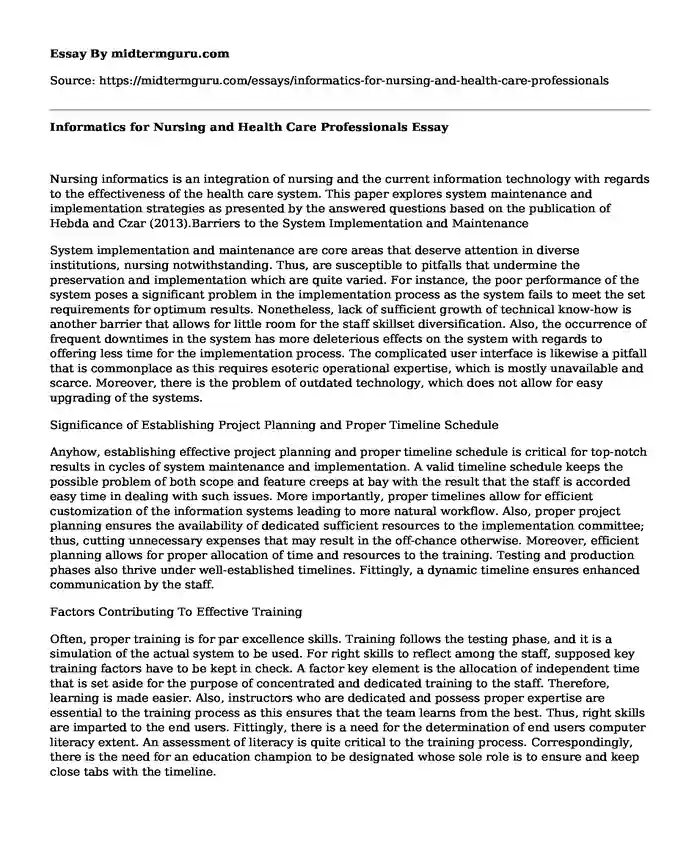Nursing informatics is an integration of nursing and the current information technology with regards to the effectiveness of the health care system. This paper explores system maintenance and implementation strategies as presented by the answered questions based on the publication of Hebda and Czar (2013).Barriers to the System Implementation and Maintenance
System implementation and maintenance are core areas that deserve attention in diverse institutions, nursing notwithstanding. Thus, are susceptible to pitfalls that undermine the preservation and implementation which are quite varied. For instance, the poor performance of the system poses a significant problem in the implementation process as the system fails to meet the set requirements for optimum results. Nonetheless, lack of sufficient growth of technical know-how is another barrier that allows for little room for the staff skillset diversification. Also, the occurrence of frequent downtimes in the system has more deleterious effects on the system with regards to offering less time for the implementation process. The complicated user interface is likewise a pitfall that is commonplace as this requires esoteric operational expertise, which is mostly unavailable and scarce. Moreover, there is the problem of outdated technology, which does not allow for easy upgrading of the systems.
Significance of Establishing Project Planning and Proper Timeline Schedule
Anyhow, establishing effective project planning and proper timeline schedule is critical for top-notch results in cycles of system maintenance and implementation. A valid timeline schedule keeps the possible problem of both scope and feature creeps at bay with the result that the staff is accorded easy time in dealing with such issues. More importantly, proper timelines allow for efficient customization of the information systems leading to more natural workflow. Also, proper project planning ensures the availability of dedicated sufficient resources to the implementation committee; thus, cutting unnecessary expenses that may result in the off-chance otherwise. Moreover, efficient planning allows for proper allocation of time and resources to the training. Testing and production phases also thrive under well-established timelines. Fittingly, a dynamic timeline ensures enhanced communication by the staff.
Factors Contributing To Effective Training
Often, proper training is for par excellence skills. Training follows the testing phase, and it is a simulation of the actual system to be used. For right skills to reflect among the staff, supposed key training factors have to be kept in check. A factor key element is the allocation of independent time that is set aside for the purpose of concentrated and dedicated training to the staff. Therefore, learning is made easier. Also, instructors who are dedicated and possess proper expertise are essential to the training process as this ensures that the team learns from the best. Thus, right skills are imparted to the end users. Fittingly, there is a need for the determination of end users computer literacy extent. An assessment of literacy is quite critical to the training process. Correspondingly, there is the need for an education champion to be designated whose sole role is to ensure and keep close tabs with the timeline.
Disparity between Testing, Training and Production Settings
Nonetheless, the key elements essential to the efficient system implementation and maintenance are testing, training, and production phases. Each phase is distinct and separate from the other. For starters, testing phase refers to where the initial programming changes are made. In this environment, the changes made are in turn confirmed as accurate. The testing phase has the roles of identifying, correcting and troubleshooting the software problems. Consequently, after the testing, training follows almost immediately. Training environment involves simulation of the actual system and mainly deals with issues related to familiarizing the staff with the prerequisite skills to handle issues affecting the system implementation and management. It is at this stage that the production environment is fruitful. The production environment mainly establishes the suitability of the system and deals with issues relating to the system being operational and; thus, able to process the supposed clients data. Thus far, each environment serves its sole mandate and usage.
Reference
Hebda, T., & Czar, P. (2013). Handbook of informatics for nurses & healthcare professionals. Boston, MA: Pearson.
Cite this page
Informatics for Nursing and Health Care Professionals. (2021, May 19). Retrieved from https://midtermguru.com/essays/informatics-for-nursing-and-health-care-professionals
If you are the original author of this essay and no longer wish to have it published on the midtermguru.com website, please click below to request its removal:
- Analysis and Presentation of Data in Pharmacology - Essay Sample
- Discussion Questions on the Public Health in Syria - Paper Example
- Critical Essay on Public Health Policies and the American Sickness: How Health Care Become Big Business
- Research Paper on Malaria Disease
- IAP-Linked Environmental Deaths: A Cause for Alarm in Society - Research Paper
- Navigating Credible Information Sources: A Guide for Nursing Professionals - Essay Sample
- Tuberculosis: 150 Million-Year-Old Disease With Lasting Social Effects - Research Paper







